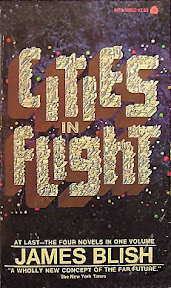 My brother Larry bought me a bag of 12 John Brunner books at a garage sale. I will be reading these soon, but in the bag were a few other books and I picked up Cities in Flight, which has all four of James Blish’s novels about the far future where the City of New York lifts off of Earth and travels the space lanes looking for commerce. I previously reviewed Year 2018!, which in this book is titled They Shall Have Stars.
My brother Larry bought me a bag of 12 John Brunner books at a garage sale. I will be reading these soon, but in the bag were a few other books and I picked up Cities in Flight, which has all four of James Blish’s novels about the far future where the City of New York lifts off of Earth and travels the space lanes looking for commerce. I previously reviewed Year 2018!, which in this book is titled They Shall Have Stars.
This is a review of the second book, A Life for the Stars.
A Life for the Stars is the story of a boy who lives outside of Scranton Pennsylvania in a far future where the economy of Earth has been shattered and many of the cities have constructed a "spindizzy" drive that lifts the whole city off the earth and into space. These cities are the migrant workers of space or "Okies". The boy is conscripted as a laborer just as Scranton takes off and starts his life for the Stars. Eventually he is traded to the City of New York and there he grows up, having adventures along the way until the City of New York meets Scranton again in a dangerous encounter.
I read this for the first time about 45 years when it was newly published in the pages of Analog. I have read it two or three times since, but I remembered very little of it and reading it again was a real pleasure. Of the Cities in flight books, I think this is the best one. It creates a believable future that is mixture of the old city of New York and the new technology of faster than light drive mixed with the science of Eugenics. It is a great book for a high school or freshman college class to discuss. It is also a fine example of what made the Golden Age of Science Fiction great.
The book’s only flaw is that the conflicts are a little light-weight considering Blish’s grand vision of the future. The plot lines seem short and almost trivial compared to the fantastic imagery of a giant city lifting in a bubble of energy and shoot across space. I expected more danger and more drama. Instead there were several smaller plots strung together as though they were written as short stories. There was no romance and not much growth in the characters. I think this is because the novel was serialized in several issues of the magazine and I suspect that Campbell, the editor, may have chopped it somewhat to make the novel fit better into that format.